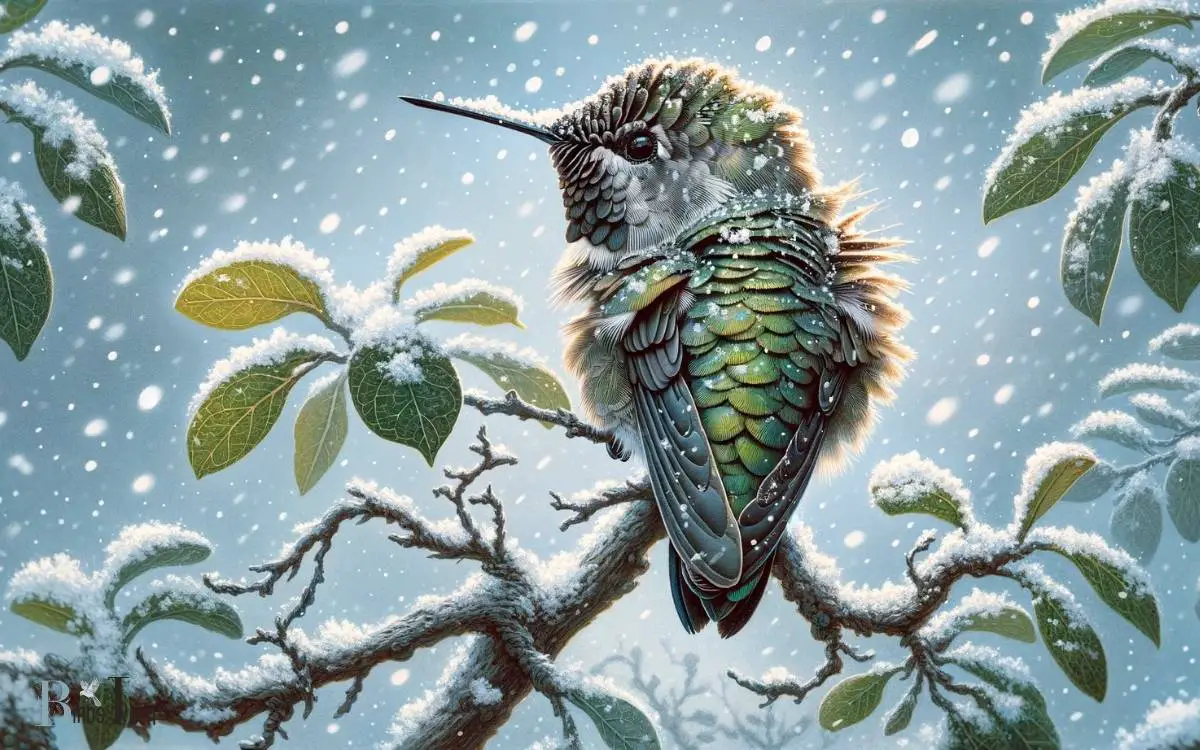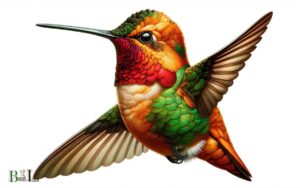How Do Anna’s Hummingbirds Survive Winter? Torpor!
Anna’s hummingbirds (Calypte anna) have evolved a variety of survival mechanisms to withstand the winter cold in their native habitats along the western coast of North America.
These tiny birds, known for their iridescent plumage and rapid wingbeat, can survive in temperatures that drop below freezing by slowing down their metabolism, entering a state of torpor, utilizing insulating nesting materials, adapting their feeding patterns, and finding sheltered roosting spots.
Surviving winter is a challenge for Anna’s hummingbirds due to their small size and high metabolic rates.
Here’s how they adapt:
Example: On a cold night, an Anna’s hummingbird may enter torpor, reducing its heart rate from 1,200 beats per minute to fewer than 50 beats per minute.
The remarkable winter resilience of Anna’s hummingbirds showcases nature’s adaptability and the intricate survival strategies of small birds.

Key Takeaway
Unique Physiological Adaptations
During winter, Anna’s Hummingbirds survive through unique physiological adaptations that enable them to maintain their metabolic rate and body temperature.
These remarkable birds possess several key adaptations that allow them to thrive in cold environments.
One such adaptation is their ability to enter a state of torpor during the night or periods of inactivity. Torpor is a temporary decrease in metabolic rate and body temperature, effectively allowing the hummingbirds to conserve energy.
Additionally, they have specialized feathers that provide insulation and help retain body heat. Their high metabolic rate also aids in generating internal heat.
These physiological adaptations collectively enable Anna’s Hummingbirds to endure the harsh conditions of winter.
Lowered Metabolic Rate
Anna’s Hummingbirds lower their metabolic rate as a crucial survival strategy during the winter months, allowing them to conserve energy and endure the challenging conditions.
This lowered metabolic rate is a remarkable adaptation that enables these tiny birds to thrive in cold climates.
The following are ways in which Anna’s Hummingbirds utilize this strategy:
- Torpor: They enter a state of torpor during the coldest periods, reducing their metabolic rate by as much as 95% to conserve energy.
- Nighttime Energy Conservation: Their metabolic rate decreases significantly at night, allowing them to minimize energy expenditure during the coldest part of the day.
- Reduced Activity: They limit their physical activity to further reduce energy consumption, utilizing only essential movements for foraging and survival.
This remarkable ability to lower their metabolic rate is a key factor in their ability to survive harsh winter conditions.
Torpor State
Anna’s Hummingbirds’ entry into a torpor state is a highly effective mechanism for drastically reducing their metabolic rate, thereby conserving energy during the winter months.
This state of controlled hypothermia allows these tiny birds to save energy when food sources are scarce.
During torpor, their heart rate decreases from around 1,200 beats per minute to as low as 50 beats per minute, and their body temperature can plummet from 105 degrees Fahrenheit to as low as 50 degrees Fahrenheit.
This dramatic reduction in metabolic activity enables them to survive cold nights when their normal high-energy lifestyle would otherwise be unsustainable.
This adaptive strategy not only allows Anna’s Hummingbirds to endure harsh winter conditions but also underscores their remarkable ability to thrive in diverse environments.
Insulated Nesting Habits
Anna’s Hummingbirds exhibit remarkable nesting habits that contribute to their survival during winter.
Their natural insulation methods, such as utilizing spider silk to bind nesting material and incorporating insulating materials like feathers and moss, play a crucial role in maintaining warmth.
Additionally, their strategic selection of nesting locations and the compact design of their nests help conserve heat, providing them with a vital advantage in the harsh winter environment.
Natural Insulation Methods
The Anna’s hummingbirds employ natural insulation methods by huddling closely together in their nests to conserve heat during the winter months. Their insulated nesting habits play a crucial role in their survival during cold weather.
Here’s how they do it:
- Feathered Blankets: Anna’s hummingbirds line their nests with soft plant materials, feathers, and even spider silk to create a cozy and insulated environment.
- Huddling Behavior: These tiny birds huddle closely together during cold nights, sharing body heat and reducing heat loss.
- Torpor State: In extremely cold conditions, Anna’s hummingbirds enter a torpor state, slowing down their metabolic rate to conserve energy and maintain body heat.
These natural insulation methods allow Anna’s hummingbirds to withstand winter temperatures and thrive in their habitats.
Nesting Material Selection
During the nesting material selection process, Anna’s hummingbirds strategically choose soft plant materials, feathers, and even spider silk to create a well-insulated environment for their nests, contributing to their survival during winter.
The soft plant materials, such as thistle down and dandelion seeds, provide excellent insulation due to their fine, airy structure. Feathers, especially those from downy plants like willows, aid in trapping warm air within the nest.
Additionally, the use of spider silk further reinforces the structural integrity of the nest while adding an extra layer of insulation.
This meticulous selection of nesting materials allows Anna’s hummingbirds to create a warm and insulated environment that helps protect their eggs and nestlings from the cold winter temperatures.
These insulated nesting habits seamlessly transition into their heat conservation strategies, ensuring their survival during the harsh winter months.
Heat Conservation Strategies
To ensure their survival during winter, Anna’s hummingbirds employ insulated nesting habits as part of their heat conservation strategies.
These tiny birds have remarkable ways of conserving heat within their nests, allowing them to withstand cold temperatures.
- Nest Location: Anna’s hummingbirds strategically place their nests in sheltered locations, such as on branches with overhanging leaves or in dense shrubbery, to shield them from the chilling effects of wind and weather.
- Nesting Materials: They use insulating materials like soft plant fibers, feathers, and moss to line their nests, providing a cozy and warm environment for their eggs and chicks.
- Nest Structure: The shape and compactness of the nest also aid in heat conservation, minimizing heat loss and maintaining a stable microclimate inside.
Feeding Strategies
Anna’s hummingbirds exhibit remarkable feeding strategies to survive the challenges of winter.
Their high metabolism and energy demands are sustained through sugar-water consumption, allowing them to maintain their activity levels.
Additionally, the birds forage in cold temperatures, demonstrating a unique adaptation to find food sources even in adverse conditions.
Sugar-Water Consumption
In the context of sustaining themselves through winter, Anna’s hummingbirds rely on increasing their sugar-water consumption to maintain their energy levels and survive the colder months.
This feeding strategy allows them to adapt to the scarcity of natural nectar sources during this time.
The increased sugar-water intake serves as a crucial energy source for their elevated metabolic rate, enabling them to endure the harsh weather conditions.
- Metabolic Efficiency: The high sugar content in their diet provides a quick energy boost, essential for maintaining their metabolic efficiency.
- Thermoregulation: The additional sugar intake aids in regulating their body temperature, vital for surviving the cold nights.
- Sustained Activity: By consuming more sugar-water, Anna’s hummingbirds can sustain their foraging and territorial activities, ensuring their survival through the winter months.
This increased sugar-water consumption is a key adaptation that supports their survival in the challenging winter environment, facilitating their ability to forage in the cold.
Foraging in Cold
During winter, Anna’s hummingbirds adapt their foraging strategies to efficiently acquire essential nutrients in the cold environment.
To maintain their high metabolic rate, these birds increase their consumption of floral nectar, which provides the necessary energy in the form of sucrose. They also rely on small insects and spiders, which are excellent sources of protein and fats.
The hummingbirds meticulously search for these tiny arthropods by carefully inspecting the undersides of leaves, flowers, and twigs.
Additionally, they may visit sap wells drilled by woodpeckers, where they can feed on the sugary sap and catch insects attracted to it.
This diverse foraging behavior allows Anna’s hummingbirds to sustain their energy requirements during the winter months, ensuring their survival in the cold climate.
Winter Roosting Behavior
Throughout the winter months, Anna’s hummingbirds seek shelter in protected locations to roost during the cold nights.
Their winter roosting behavior is fascinating to observe and is essential for their survival in colder climates.
Here are some key aspects of their winter roosting behavior:
- Shelter Selection: Anna’s hummingbirds often select roosting spots that are well-insulated and protected from harsh weather conditions. These spots may include dense foliage, tree cavities, or even human-made structures such as sheds or garages.
- Torpor: During particularly cold nights, Anna’s hummingbirds enter a state of torpor, where their metabolic rate and body temperature decrease significantly, allowing them to conserve energy and endure the cold more effectively.
- Communal Roosting: In some cases, multiple Anna’s hummingbirds may roost together in a communal fashion, sharing body heat and huddling closely to stay warm throughout the night.
Energy Conservation Techniques
To ensure their survival during the winter months, Anna’s hummingbirds employ energy conservation techniques that are crucial for maintaining their metabolic functions and enduring the colder climate.
These tiny birds have remarkable adaptations for surviving the winter, including entering a state of torpor during cold nights, where their metabolic rate and body temperature significantly decrease to conserve energy.
Additionally, they have the ability to enter a state of daily torpor, reducing their energy expenditure during periods of food scarcity.
The table below provides a summary of the energy conservation techniques employed by Anna’s hummingbirds:
| Energy Conservation Technique | Description |
|---|---|
| Torpor during cold nights | Drastically lowers metabolic rate and body temp |
| Daily torpor | Reduces energy expenditure during food scarcity |
These energy conservation strategies are essential for Anna’s hummingbirds to survive the challenges of winter.
Survival Challenges
Survival challenges frequently confront Anna’s hummingbirds during the winter months, necessitating adaptive strategies for their continued existence.
These challenges include:
- Food scarcity: As flowers and insects become scarce in the winter, Anna’s hummingbirds must expand their foraging range and adapt to new food sources to meet their high metabolic needs.
- Temperature regulation: The plummeting winter temperatures pose a significant challenge for these small birds. They combat the cold by entering a state of torpor at night, lowering their metabolic rate and body temperature to conserve energy.
- Competition and predation: During winter, resources become limited, leading to increased competition among hummingbirds.
Additionally, the risk of predation rises as fewer hiding spots are available in the bare winter landscape, requiring heightened vigilance and strategic shelter selection.
Conclusion
Anna’s hummingbirds demonstrate remarkable physiological adaptations to survive winter. Their lowered metabolic rate, torpor state, insulated nesting habits, and feeding strategies enable them to conserve energy and withstand the challenges of the cold season.
Their unique winter roosting behavior further contributes to their survival in harsh conditions. These survival mechanisms showcase the resilience and resourcefulness of Anna’s hummingbirds in adapting to their environment.






